వాజపేయికి బంగ్లా ప్రకటించిన యుద్ధ విమోచన గౌరవ అవార్డును అందుకున్న
ప్రధాని మోదీ
-తనతో సహా ఎంతోమంది రాజకీయనేతలకు వాజపేయి స్ఫూర్తి అని వెల్లడి
-ప్రతిపక్ష నేత ఖలీదా జియాతో భేటీ.. ఢాకేశ్వరి ఆలయం, రామకృష్ణ మఠ్ను
సందర్శించిన మోదీ
ఢాకా, జూన్ 7: మాజీ ప్రధాని వాజపేయిని బంగ్లాదేశ్ ప్రతిష్ఠాత్మక అవార్డుతో
సత్కరించడం ఎంతో గర్వకారణమని ప్రధాని నరేంద్రమోదీ పేర్కొన్నారు. బంగ్లాదేశ్
విముక్తికి ప్రతిపక్ష నేత హోదాలో వాజపేయి ఎనలేని కృషి చేశారని
వెల్లడించారు. బంగ్లా విముక్తికి క్రియాశీల పాత్రపోషించినందుకు వాజపేయికి
బంగ్లాదేశ్ ప్రకటించిన ప్రతిష్ఠాత్మక యుద్ధ విమోచన గౌరవ (లిబరేషన్ వార్
హానర్) పురస్కారాన్ని.. ఆయన తరఫున ప్రధాని నరేంద్రమోదీ అందుకున్నారు.
బంగ్లాదేశ్ అధ్యక్ష భవనమైన బంగభవన్లో ఆదివారం జరిగిన కార్యక్రమంలో ఆ దేశ
అధ్యక్షుడు అబ్దుల్ హమీద్ ఈ పురస్కారాన్ని మోదీకి అందజేశారు. అనంతరం మోదీ
ప్రసంగిస్తూ.. తనతో సహా మరెంతోమంది రాజకీయ నేతలకు వాజపేయి స్ఫూర్తిప్రదాత
అని కొనియాడారు. ప్రయాణం చేయలేని స్థితిలో ఉన్నందున వాజపేయి ఈ అవార్డు
స్వీకరించేందుకు రాలేకపోయారని
చెప్పారు. అటల్ బిహారీ వాజపేయి వంటి నాయకుడికి పొరుగుదేశంనుంచి గొప్ప
పురస్కారం లభించినందుకు దేశ ప్రజలందరూ గర్వపడాల్సిన రోజు.
ఆయన జీవితం మొత్తం దేశసేవకే అంకితమిచ్చారు. రాజకీయ కోణంలో ఆలోచిస్తే..
నాతో సహా దేశంలోని ఎంతోమంది రాజకీయ నేతలకు ఆయన గొప్ప స్ఫూర్తిప్రదాత అని
కొనియాడారు. బంగ్లాదేశ్ విముక్తికి వాజపేయి చేసిన పోరాటాన్ని ఆహుతుల
హర్షధ్వానాల మధ్య మోదీ గుర్తుచేశారు. నాడు వాజపేయి ప్రతిపక్ష నాయకుడిగా
బంగ్లా విముక్తికి సత్యాగ్రహ దీక్ష చేపట్టారని పేర్కొన్నారు. అందులో యువ
వలంటీర్గా తాను కూడా పాల్గొన్నట్లు చెప్పారు. బంగ్లాదేశ్ ప్రజల కల నిజం
కావాలని మనస్ఫూర్తిగా కోరుకున్నామని తెలిపారు. జూన్ 6, 1971న పార్లమెంట్లో
వాజపేయి ప్రసంగిస్తూ.. బంగ్లాదేశ్ను స్వతంత్ర దేశంగా గుర్తించాలని..
బంగ్లా పోరాట యోధులకు తగిన సహాయం అందించాలని ప్రభుత్వాన్ని కోరారని ఈ
సందర్భంగా మోదీ గుర్తు చేశారు. అనంతరం బంగ్లాదేశ్ ప్రధాని షేక్ హసీనా
మాట్లాడుతూ విముక్తి పోరులో భారత్ అండగా ఉండటం బంగ్లాదేశ్ అదృష్టమని
పేర్కొన్నారు. దేశ స్వాతంత్య్రానికి వాజపేయి గొప్ప సహకారం అందించారని ఆమె
కొనియాడారు.
కార్యక్రమం అనంతరం ప్రధాని మోదీకి అధ్యక్షుడు హమీద్ విందు ఇచ్చారు. ఈ
సందర్భంగా అధ్యక్షుడు హమీద్తో ద్వైపాక్షిక చర్చలు జరిపినట్లు విదేశీ
వ్యవహారాల శాఖ అధికార ప్రతినిధి వికాస్స్వరూప్ ట్వీట్ చేశారు. కాగా, భారత
కంపెనీలకు రెండు ప్రత్యేక ఆర్థిక మండళ్ల ఏర్పాటుకు అనుమతిస్తూ బంగ్లాదేశ్
నిర్ణయం తీసుకుంది. మొంగ్లా, భెరమారాలో రెండు సెజ్ల ఏర్పాటుకు బంగ్లాదేశ్
అనుమతిచ్చింది. ప్రధాని మోదీ పర్యటనను బంగ్లా మీడియా కీర్తించింది. అన్ని
పత్రికలు మోదీ పర్యటనతో కొత్త అధ్యాయం ప్రారంభమైందని కొనియాడాయి.
మోదీతో ప్రతిపక్షనేతల భేటీ
ప్రధాని మోదీతో బంగ్లాదేశ్ మాజీ ప్రధాని ఖలీదా జియా భేటీ అయ్యారు.
బంగ్లాదేశ్లో ప్రజాస్వామ్యాన్ని పునరుద్ధరించాలని.. మళ్లీ ఎన్నికలు
నిర్వహించాలన్న విషయంలో జోక్యం చేసుకోవాలని ఆమె కోరారు. అంతకుముందు
బంగ్లాదేశ్ ప్రతిపక్ష నాయకురాలు రౌషన్ ఎర్షాద్ సమావేశమయ్యారు. అనంతరం పలు
వామపక్ష పార్టీ నేతలతో భేటీ అయ్యారు. కాగా, భారత్-బంగ్లాదేశ్ మధ్య బస్సు
సర్వీసుకు తమకేమీ అభ్యంతరం లేదని ఖలీదా జియాకు చెందిన పార్టీ ప్రకటించింది.
అయితే బంగ్లాదేశ్కు ఫీజు చెల్లించాలని ఆ పార్టీ నేత ఒకరు పేర్కొన్నారు.
బంగ్లా సరిహద్దు వెంట కంచె
బంగ్లాదేశ్తో ఉన్న నదీ సరిహద్దు వెంట తేలికపాటి కంచె వేయాలని సరిహద్దు
భద్రతా దళం (బీఎస్ఎఫ్) నిర్ణయించింది. నది మధ్యనుంచి ఈ కంచె వేయాలని
అధికారులు ప్రణాళికలు రచించారు. ఈ ప్రాజెక్టును కేంద్ర ప్రజా పనుల విభాగం
(సీపీడబ్ల్యూడీ) చేపడుతుందని కోల్కతాలో బీఎస్ఎఫ్ ఐటీ సందీప్ సలుంకె
తెలిపారు.
ఢాకేశ్వరి ఆలయంలో మోదీ పూజలు
12వ శతాబ్దానికి చెందిన ఢాకేశ్వరి (ఢాకా దేవత) ఆలయాన్ని ప్రధాని మోదీ
సందర్శించారు. ఈ సందర్భంగా ఆయన ప్రత్యేక పూజలు చేశారు. బంగ్లాదేశ్లోని
అత్యధికమంది హిందువులు ఈ ఆలయాన్ని సందర్శిస్తుంటారు. శక్తిపీఠాల్లో ఒకటైన ఈ
ఆలయంలో మోదీ 15నిమిషాలపాటు గడిపారు. ఈ సందర్భంగా విమోచన యుద్ధంలో సెక్టార్
కమాండర్ మేజర్ జనరల్గా పనిచేసిన సీఆర్ దత్తా మోదీకి తెలుపు, ఎరుపు రంగుల
దట్టీ కట్టారు. ఈ దేవత పేరునుంచే ఢాకాకు ఆ పేరు వచ్చిందని కొందరి విశ్వాసం.
1996లో ఈ ఆలయాన్ని ప్రభుత్వం ఆధీనంలోకి తీసుకుని.. జాతీయ వారసత్వ సంపదగా
ప్రకటించింది. అనంతరం మోదీ రామకృష్ణ మిషన్ను సందర్శించారు.
ఒప్పందాలను తక్షణమే అమలుచేస్తాం
-సంయుక్త ప్రకటనలో ప్రధానులు మోదీ, హసీనా
ఢాకా, జూన్ 7: భారత్, బంగ్లాదేశ్ మధ్య కుదిరిన ద్వైపాక్షిక ఒప్పందాలను
తక్షణమే అమల్లోకితెస్తామని రెండు దేశాలు ప్రకటించాయి. చరిత్రాత్మకమైన భూ
సరిహద్దు ఒప్పందంతో సహా అన్నింటినీ సహకారాత్మక ధోరణితో అమలు చేస్తామని
రెండు దేశాల ప్రధానులు నరేంద్రమోదీ, షేక్ హసీనా ఆదివారం ఢాకాలో సంయుక్త
ప్రకటనలో వెల్లడించారు. పౌర అణు విద్యుత్, పెట్రోలియంతోపాటు పునరుత్పాదక
విద్యుత్ రంగంలోనూ కలిసికట్టుగా పనిచేస్తామని కొత్త తరం- కొత్త దిశ పేరిట
విడుదల చేసిన ప్రకటనలో ఇద్దరు నేతలు పేర్కొన్నారు. భారత్-బంగ్లా మధ్య
కుదిరిన ఒప్పందాలు వెంటనే అమలయ్యేలా చర్యలు తీసుకోవాలని ఇద్దరు ప్రధానులు
సంబంధిత అధికారులను ఆదేశించినట్లు ప్రకటన వెల్లడించింది. ఒకరికి
వ్యతిరేకంగా మరొకరు తమ తమ భూభాగాల్లో ఎలాంటి కార్యకలాపాలను అనుమతించబోమని
అంగీకరించారు.
తీస్తాకు మానవతాకోణంలో పరిష్కారం: మోదీ
ఢాకా, జూన్ 7: భారత్-బంగ్లాదేశ్ పక్కనే ఉండటం కాదని.. కలిసి నడుస్తాయి కూడా
అని ప్రధాని నరేంద్రమోదీ పేర్కొన్నారు. తీస్తా నదీ జలాల పంపిణీ రాజకీయ
కోణంతో కాకుండా.. మానవతాకోణంలో పరిష్కరించుకోవాల్సిన అవసరం ఉందని అన్నారు.
ఉగ్రవాదాన్ని పెంచిపోషిస్తున్న పాక్ భారత్కు చికాకు వ్యవహారంలా మారిందని
ధ్వజమెత్తారు. ఢాకాలోని బంగబంధు ఇంటర్నేషనల్ కన్వెన్షన్ సెంటర్, ఢాకా
యూనివర్సిటీలో ప్రసంగిస్తూ.. ఉగ్రవాదాన్ని ఎదుర్కోవడంలో బంగ్లా ప్రధాని
షేక్ హసీనా ధీరోదాత్తంగా వ్యవహరిస్తున్నారని కొనియాడారు. అనంతరం మోదీ
రెండురోజుల బంగ్లాదేశ్ పర్యటన ముగించుకుని ఢిల్లీకి చేరుకున్నారు.



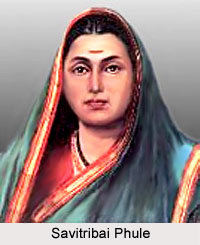
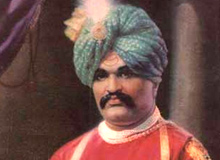 King
Shahu Chhatrapati was considered as a true democrat and social
reformer. He was an invaluable gem in the history of Kolhapur. Shahu was
associated with many progressive activities in the society including
education for women. He was greatly influenced by the contributions of
social reformer Jyotiba Phule. Primary education to all regardless of
caste and creed was one of the significant moves of the King.
King
Shahu Chhatrapati was considered as a true democrat and social
reformer. He was an invaluable gem in the history of Kolhapur. Shahu was
associated with many progressive activities in the society including
education for women. He was greatly influenced by the contributions of
social reformer Jyotiba Phule. Primary education to all regardless of
caste and creed was one of the significant moves of the King.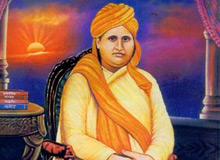 Dayanand
Saraswati was a reformer and believed in pragmatism. He preached
against many rituals of the Hindu religion such as idol-worship, caste
by birth, animal sacrifices and restrictions of women from reading
Vedas. He was not only a great scholar and philosopher but also a social
reformer and a political thinker. Dayanand Saraswati was responsible
for the revival of the Indian educational system by bringing together
pupil from different strata of the society under one umbrella, that is,
classroom.
Dayanand
Saraswati was a reformer and believed in pragmatism. He preached
against many rituals of the Hindu religion such as idol-worship, caste
by birth, animal sacrifices and restrictions of women from reading
Vedas. He was not only a great scholar and philosopher but also a social
reformer and a political thinker. Dayanand Saraswati was responsible
for the revival of the Indian educational system by bringing together
pupil from different strata of the society under one umbrella, that is,
classroom.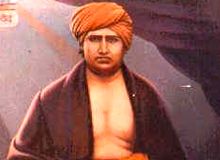 The 10 principles of Arya Samaj
The 10 principles of Arya Samaj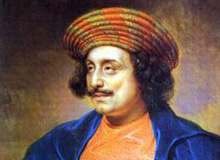 Raja
Ram Mohan Roy is considered as the pioneer of modern Indian Renaissance
for the remarkable reforms he brought in the 18th century India. Among
his efforts, the abolition of the sati-pratha-a practice in which the
widow was compelled to sacrifice herself on the funeral pyre of her
husband-was the prominent. His efforts were also instrumental in
eradicating the purdah system and child marriage. In 1828, Ram Mohan Roy
formed the Brahmo Samaj, a group of people, who had no faith in
idol-worship and were against the caste restrictions. The title 'Raja'
was awarded to him by Mughal emperor Akbar, the second in 1831 when Roy
visited England as an ambassador of the King to ensure that Bentick's
regulation of banning the practice of Sati was not overturned.
Raja
Ram Mohan Roy is considered as the pioneer of modern Indian Renaissance
for the remarkable reforms he brought in the 18th century India. Among
his efforts, the abolition of the sati-pratha-a practice in which the
widow was compelled to sacrifice herself on the funeral pyre of her
husband-was the prominent. His efforts were also instrumental in
eradicating the purdah system and child marriage. In 1828, Ram Mohan Roy
formed the Brahmo Samaj, a group of people, who had no faith in
idol-worship and were against the caste restrictions. The title 'Raja'
was awarded to him by Mughal emperor Akbar, the second in 1831 when Roy
visited England as an ambassador of the King to ensure that Bentick's
regulation of banning the practice of Sati was not overturned.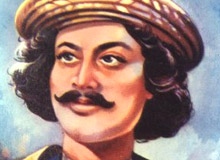 Ram
Mohan viewed education as a medium to implement the social reforms. So,
in 1815, Ram Mohan came to Calcutta and the very next year, started an
English College by putting his own savings. He was well aware that the
students should learn the English language and scientific subjects and
that's why he criticized the government's policy of opening only
Sanskrit schools. According to him, Indians would lag behind if they do
not get to study modern subjects like Mathematics, Geography and Latin.
Government accepted this idea of Ram Mohan and also implemented it but
not before his death. Ram Mohan was also the first to give importance to
the development of the mother tongue. His 'Gaudiya Byakaran' in Bengali
is the best of his prose works. Rabindranath Tagore and Bankimchandra
also followed the footsteps of Ram Mohan Roy.
Ram
Mohan viewed education as a medium to implement the social reforms. So,
in 1815, Ram Mohan came to Calcutta and the very next year, started an
English College by putting his own savings. He was well aware that the
students should learn the English language and scientific subjects and
that's why he criticized the government's policy of opening only
Sanskrit schools. According to him, Indians would lag behind if they do
not get to study modern subjects like Mathematics, Geography and Latin.
Government accepted this idea of Ram Mohan and also implemented it but
not before his death. Ram Mohan was also the first to give importance to
the development of the mother tongue. His 'Gaudiya Byakaran' in Bengali
is the best of his prose works. Rabindranath Tagore and Bankimchandra
also followed the footsteps of Ram Mohan Roy.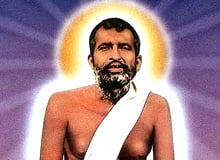 Sri
Ramakrishna Paramhansa was a popular saint of India. He had a strong
faith in the existence of god. He regarded every woman of the society,
including his wife, Sarada, as holy mother. Swami Vivekananda was one of
the prominent disciples of Ramakrishna, who later formed the
Ramakrishna Mission.
Sri
Ramakrishna Paramhansa was a popular saint of India. He had a strong
faith in the existence of god. He regarded every woman of the society,
including his wife, Sarada, as holy mother. Swami Vivekananda was one of
the prominent disciples of Ramakrishna, who later formed the
Ramakrishna Mission.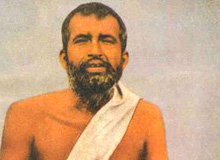 Sri
Ramakrishna was the most 'rational mystic'. With scientific precision
he put forward in most simple terms, as parables and stories, the
eternal truth regarding God and God realization. He talked about God
only after directly experiencing the reality of God. To get rid of the
thought that he belonged to a higher brahmanical caste, he began to eat
food cooked by the shudras or lower-caste.
Sri
Ramakrishna was the most 'rational mystic'. With scientific precision
he put forward in most simple terms, as parables and stories, the
eternal truth regarding God and God realization. He talked about God
only after directly experiencing the reality of God. To get rid of the
thought that he belonged to a higher brahmanical caste, he began to eat
food cooked by the shudras or lower-caste.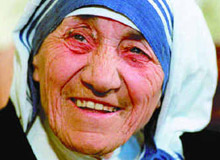 Mother
Teresa was a true follower of humanity. Many people considered Mother
as the "reincarnated form of Lord Jesus". Mother Teresa devoted her
entire life in serving the needy and abandoned people of the society.
Although her mission started in India, she succeeded in bringing the
people of all societies under one roof, i.e. humanity. Besides the Nobel
Peace Prize, she was also awarded with Ramon Magsaysay and Padmashri
Award for her social works.
Mother
Teresa was a true follower of humanity. Many people considered Mother
as the "reincarnated form of Lord Jesus". Mother Teresa devoted her
entire life in serving the needy and abandoned people of the society.
Although her mission started in India, she succeeded in bringing the
people of all societies under one roof, i.e. humanity. Besides the Nobel
Peace Prize, she was also awarded with Ramon Magsaysay and Padmashri
Award for her social works.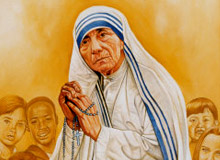 The
Missionaries of Charity was formed by Mother Teresa in 1950. Today, it
consists of over 4,000 nuns. The organization, so far, has expanded its
wings to over 100 countries. The objective of the Missionaries of
Charity is to provide care and support to the sick, mentally ill, aged,
victims of incorrigible diseases, and abandoned children. The
Missionaries of Charity has opened around 20 homes in Calcutta including
a school for street children.
The
Missionaries of Charity was formed by Mother Teresa in 1950. Today, it
consists of over 4,000 nuns. The organization, so far, has expanded its
wings to over 100 countries. The objective of the Missionaries of
Charity is to provide care and support to the sick, mentally ill, aged,
victims of incorrigible diseases, and abandoned children. The
Missionaries of Charity has opened around 20 homes in Calcutta including
a school for street children.


